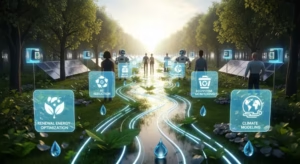How AI is Reshaping the Future of Environmental Sustainability

The blog post explores how AI is reshaping the future of environmental sustainability, emphasizing its crucial role in tackling climate change and enhancing ecological efforts. It delves into the intersection of climate change technology and AI, highlighting innovative applications that improve resource management and reduce carbon footprints. The article discusses both advantages, such as increased efficiency and data analysis capabilities, and challenges, including ethical considerations and technological limitations in implementing sustainable AI solutions. Furthermore, it proposes actionable next steps for leveraging AI in environmental sustainability efforts, underscoring the importance of collaboration between technology and environmental science. Overall, the article presents a comprehensive view of how AI in environmental sustainability can drive meaningful change and promote a greener future.
Understanding The Role Of AI In Environmental Sustainability

The integration of AI in environmental sustainability is revolutionizing how we approach ecological challenges. By leveraging advanced algorithms and data analytics, AI helps identify patterns, predict environmental changes, and optimize resource management. This technology enables organizations to achieve a more sustainable future by enhancing efficiency in various sectors, from agriculture to waste management. Furthermore, the ability of AI to process vast amounts of data in real-time leads to more informed decision-making, promoting greener practices that can significantly reduce carbon footprints.
Key Areas AI Impacts Environmental Sustainability
- Resource optimization in energy consumption
- Enhancing biodiversity through wildlife tracking
- Improving agricultural practices via precision farming
- Streamlining waste management systems
- Facilitating efficient water management
- Predicting climate changes and their impacts
- Supporting clean technology innovations
AI’s contributions to green technology extend beyond immediate applications, fostering a culture of continuous improvement in environmental stewardship. Businesses that adopt AI-driven solutions can not only lower operational costs but also enhance their reputation as environmentally responsible organizations. Additionally, The synergy between advanced technology and ecological responsibility creates a pathway for fostering sustainable growth in all industries. As we explore the multifaceted relationship between AI and sustainability, it becomes evident that the collaboration of both can pave the way for an eco-friendlier world.
Exploring The Intersection Of Climate Change Tech And AI For Ecology

As the world confronts the rapid effects of climate change, the integration of AI for ecology presents transformative avenues to bolster environmental sustainability. By harnessing advanced technologies, we can foster innovative solutions that address ecological challenges effectively. This intersection of climate change tech and artificial intelligence not only paves the way for informed decision-making but also aids in predictive analytics, enabling proactive environmental management.
AI technologies can optimize various sectors vital for sustainability, particularly in energy and waste management. Through machine learning and data analysis, businesses are increasingly able to manage resources more efficiently and reduce their carbon footprints. Consequently, this collaborative approach harnesses the capability of AI to enhance traditional ecological practices, offering a roadmap to a sustainable future.
Impact of AI Applications in Climate Change Tech
| AI Application | Impact Area | Benefits |
|---|---|---|
| Predictive Analytics | Energy Management | Increased efficiency and reduced waste |
| Smart Grids | Renewable Energy | Optimized energy distribution |
| Resource Tracking | Waste Management | Enhanced recycling and reduction of landfill waste |
| Pollution Monitoring | Air Quality | Improved public health outcomes |
To fully realize the potential of AI in environmental sustainability, it is essential to systematically implement strategic frameworks. By understanding the capabilities of AI, organizations can effectively address complex environmental issues and allocate resources judiciously. Below are steps to implement AI in climate change solutions:
Steps To Implement AI In Climate Change Solutions
- Assess the current environmental challenges and data availability.
- Identify specific areas where AI can provide solutions.
- Engage stakeholders across sectors for collaborative approaches.
- Develop a clear AI strategy with defined goals and metrics.
- Invest in technological infrastructure and training.
- Pilot AI initiatives with scalable projects.
- Monitor outcomes and refine processes for continuous improvement.
AI Applications In Renewable Energy
Renewable energy stands at the forefront of climate change tech, where AI plays a pivotal role in optimizing energy production and consumption. For instance, predictive algorithms can forecast energy needs, adapting supply and distribution accordingly. This results in reduced reliance on fossil fuels and promotes the integration of renewable sources like wind and solar into the energy grid. Vendors utilizing AI in environmental sustainability are better positioned to manage these resources effectively, contributing to a cleaner, greener world.
AI-Driven Waste Management
Waste management is another sector benefiting significantly from AI applications. Implementing smart waste collection systems powered by AI algorithms enhances sorting processes while maximizing recycling efforts. By using AI to monitor waste patterns, cities can efficiently allocate resources, minimize landfill usage, and reduce emissions. Such advancements not only improve operational efficiency but also actively contribute to restoring ecological balance through reduced waste generation.
Advantages And Challenges Of Sustainable AI In Green Technology

Incorporating sustainable AI into green technology has the potential to revolutionize the way we approach environmental challenges. The primary advantage of this integration is its ability to optimize resource management. For instance, AI algorithms can analyze vast amounts of data from sensors to enhance energy efficiency in real-time, minimizing waste and lowering carbon footprints. Additionally, sustainable AI can innovate new materials and processes, making green technologies more effective and accessible.
| Advantage | Impact | Example |
|---|---|---|
| Resource Optimization | Reduced energy use | Smart grids adjusting to demand |
| Innovative Materials | New sustainable products | Biodegradable plastics |
| Data-Driven Solutions | Informed decision-making | Predictive maintenance in renewable energy |
| Scalability | Broader adoption of green tech | AI in urban planning |
However, the integration of sustainable AI also poses several challenges. There are concerns over data privacy and the environmental impact of energy-intensive AI models. Operational transparency in AI decision-making processes is critical, yet often lacking, which could lead to mistrust among users and stakeholders. Moreover, the high cost of implementing advanced AI solutions may deter smaller enterprises from participating in sustainable initiatives.
Benefits Of Sustainable AI
- Enhances energy efficiency through real-time analytics
- Facilitates the development of eco-friendly materials
- Provides data-driven insights for informed policy-making
- Improves predictive analytics for climate resilience
- Increases scalability of green technologies
- Supports smart cities through optimized resource usage
- Drives economic growth in sustainability sectors
In summary, while the emergence of AI in environmental sustainability presents promising advantages for enhancing green technology, it is imperative to address the accompanying challenges. Through collaborative efforts across sectors, stakeholders can leverage effective AI-driven solutions while ensuring social, ethical, and ecological considerations are prioritized. The path forward will involve a blend of innovation, regulation, and continuous learning to maximize the benefits of sustainable AI in shaping a greener future.
Next Steps For Harnessing AI In Environmental Sustainability Efforts

As we move towards a more sustainable future, the integration of AI in environmental sustainability presents tremendous opportunities for innovation and efficiency. From smart grid management to precision agriculture, AI can significantly enhance our capabilities in addressing pressing environmental challenges. To fully leverage the potential of AI technologies, organizations and governments must focus on actionable strategies that promote sustainable practices, ultimately reducing the impact of climate change.
Actionable Steps To Implement AI
- Conduct a comprehensive assessment of current environmental challenges within your organization.
- Identify AI tools that align with sustainability goals and can effectively address specific issues.
- Develop a clear strategy for data collection and integration to drive AI solutions.
- Engage stakeholders and create partnerships with tech companies specializing in climate change tech.
- Train employees and stakeholders on AI applications and sustainable practices.
- Monitor and evaluate the effectiveness of implemented AI solutions regularly.
- Scale successful initiatives and share outcomes with the wider community to inspire further adoption.
By embracing these structured steps, organizations can take a proactive approach to implementing AI technologies in their sustainability efforts. This will not only enhance operational efficiency but also contribute to greater environmental impact reduction. As companies and governments increasingly recognize the importance of AI in environmental sustainability, collaboration across sectors will become vital in developing robust solutions to combat climate change and promote ecological conservation.
Briefing Document: AI in Environmental Sustainability
This briefing paper explores the multifaceted role of Artificial Intelligence (AI) in addressing environmental challenges, highlighting its potential to combat climate change, enhance ecological efforts, and enable a greener future. It highlights both the significant advantages of integrating AI into sustainability initiatives and the critical challenges that must be addressed for effective implementation.
Main Themes and Key Ideas
The source predominantly revolves around the transformative impact of AI on environmental sustainability, focusing on its ability to optimize resource management, predict environmental changes, and facilitate informed decision-making.
1. AI as a Catalyst for Environmental Sustainability
AI is presented as a revolutionary tool for tackling ecological challenges by leveraging “advanced algorithms and data analytics” to “identify patterns, predict environmental changes, and optimize resource management.” Its ability to process vast amounts of real-time data leads to “more informed decision-making, promoting greener practices that can significantly reduce carbon footprints.”
Key Areas AI Impacts Environmental Sustainability:
- Resource optimization: Especially in energy consumption and water management.
- Biodiversity enhancement: Through wildlife tracking.
- Improved agricultural practices: Via precision farming.
- Streamlined waste management systems.
- Climate change prediction: And impact assessment.
- Support for clean technology innovations.
The source states that AI’s contributions “foster a culture of continuous improvement in environmental stewardship” and that businesses adopting AI-driven solutions can “lower operational costs but also enhance their reputation as environmentally responsible organizations.”
2. Intersection of Climate Change Technology and AI for Ecology
The integration of AI with climate change technology offers “transformative avenues to bolster environmental sustainability.” This synergy enables “innovative solutions that address ecological challenges effectively” through “predictive analytics, enabling proactive environmental management.”
Impact of AI Applications in Climate Change Tech:
- Predictive Analytics: Increases efficiency and reduces waste in energy management.
- Smart Grids: Optimize energy distribution for renewable energy sources.
- Resource Tracking: Enhances recycling and reduces landfill waste in waste management.
- Pollution Monitoring: Improves public health outcomes by monitoring air quality.
Specific Applications Highlighted:
- AI Applications in Renewable Energy: AI plays a “pivotal role in optimizing energy production and consumption.” Predictive algorithms “can forecast energy needs, adapting supply and distribution accordingly,” reducing reliance on fossil fuels and promoting renewables like wind and solar.
- AI-Driven Waste Management: AI enhances “sorting processes while maximizing recycling efforts” through smart waste collection systems. It enables cities to “efficiently allocate resources, minimize landfill usage, and reduce emissions.”
3. Advantages of Sustainable AI in Green Technology
The integration of “sustainable AI” into “green technology” offers significant benefits:
- Resource Optimization: AI algorithms can “analyze vast amounts of data from sensors to enhance energy efficiency in real-time, minimizing waste and lowering carbon footprints.” (Example: Smart grids adjusting to demand).
- Innovative Materials: AI can “innovate new materials and processes, making green technologies more effective and accessible.” (Example: Biodegradable plastics).
- Data-Driven Solutions: Provides “informed policy-making” and “predictive analytics for climate resilience.”
- Scalability: Allows for “broader adoption of green tech” and supports “smart cities through optimized resource usage.”
- Economic Growth: Drives “economic growth in sustainability sectors.”
4. Challenges and Considerations for Sustainable AI
Despite its immense potential, the implementation of sustainable AI faces several challenges:
- Data Privacy: Concerns exist regarding the privacy of data collected for AI applications.
- Environmental Impact of AI Models: Energy-intensive AI models themselves can have a significant environmental footprint, posing a paradox for “sustainable AI.”
- Operational Transparency: A critical concern is the frequent “lack of operational transparency in AI decision-making processes,” which can lead to “mistrust among users and stakeholders.”
- High Implementation Cost: “The high cost of implementing advanced AI solutions may deter smaller enterprises from participating in sustainable initiatives.”
The source emphasizes that addressing these challenges requires “collaborative efforts across sectors,” ensuring “social, ethical, and ecological considerations are prioritized.”
5. Actionable Steps for Implementation
The document outlines clear strategies for organizations and governments to “fully leverage the potential of AI technologies” in environmental sustainability:
Steps to Implement AI in Climate Change Solutions (General):
- Assess current environmental challenges and data availability.
- Identify specific areas where AI can provide solutions.
- Engage stakeholders for collaborative approaches.
- Develop a clear AI strategy with defined goals and metrics.
- Invest in technological infrastructure and training.
- Pilot AI initiatives with scalable projects.
- Monitor outcomes and refine processes for continuous improvement.
Actionable Steps to Implement AI (Organizational Focus):
- Conduct a comprehensive assessment of current environmental challenges within your organization.
- Identify AI tools that align with sustainability goals.
- Develop a clear strategy for data collection and integration.
- Engage stakeholders and create partnerships with climate change tech companies.
- Train employees and stakeholders on AI applications and sustainable practices.
- Monitor and evaluate the effectiveness of implemented AI solutions regularly.
- Scale successful initiatives and share outcomes to inspire further adoption.
The source presents a compelling argument for AI’s critical role in shaping a greener, more sustainable future. By enhancing efficiency, enabling predictive analytics, and optimizing resource management across various sectors, AI offers powerful solutions to pressing environmental challenges. However, realizing this potential requires a strategic approach that acknowledges and addresses the associated challenges of data privacy, environmental impact of AI itself, transparency, and cost. Collaboration between technology and environmental science, coupled with systematic implementation, will be crucial in maximizing the benefits of AI for environmental sustainability.
Homepage / humanaifuture.com
For similar articles, please visit: AI in Environment & Sustainability
🎧 Listen to the Podcast
Want to explore this topic in more depth? Listen to the full podcast for more insights and expert commentary.
▶️ Play on Google DriveNo sign-up needed — just click and listen.
How does AI contribute to climate change mitigation and adaptation?
AI contributes to climate change mitigation and adaptation by fostering innovative solutions that address ecological challenges effectively. It aids in predictive analytics, enabling proactive environmental management, and optimizes sectors vital for sustainability like energy and waste management. Specific applications include optimizing renewable energy production and consumption through predictive algorithms, enhancing smart grids, and improving waste collection and sorting systems to maximize recycling and minimize landfill usage.
In what key areas does AI impact environmental sustainability?
AI impacts environmental sustainability in several key areas:
- Resource optimization: Enhancing efficiency in energy consumption, water management, and overall resource allocation.
- Biodiversity enhancement: Through wildlife tracking and monitoring.
- Improved agricultural practices: Via precision farming techniques.
- Streamlining waste management: Implementing smart waste collection and sorting.
- Climate change prediction: Forecasting environmental changes and their impacts.
- Clean technology innovation: Supporting the development and adoption of green technologies.
What are the main advantages of using AI in green technology?
The main advantages of using AI in green technology include:
- Resource Optimization: AI algorithms can analyze vast amounts of data to enhance energy efficiency in real-time, minimizing waste and lowering carbon footprints.
- Innovative Materials: AI can facilitate the innovation of new sustainable materials and processes.
- Data-Driven Solutions: Providing informed decision-making through predictive analytics for climate resilience and policy-making.
- Scalability: Enabling broader adoption and implementation of green technologies, including in smart cities.
- Economic Growth: Driving economic growth within sustainability sectors.
What are the challenges associated with implementing sustainable AI solutions?
Despite its advantages, the integration of sustainable AI faces several challenges:
- Data Privacy Concerns: Issues related to the collection and use of vast amounts of environmental data.
- Environmental Impact of AI Models: The energy-intensive nature of training and running complex AI models can contribute to carbon emissions.
- Operational Transparency: Lack of transparency in AI decision-making processes can lead to mistrust among users and stakeholders.
- High Implementation Costs: The significant cost of deploying advanced AI solutions can deter smaller enterprises from participating in sustainable initiatives.
- Technological Limitations: The inherent limitations of AI technologies themselves in addressing complex, real-world environmental issues.
What steps should organizations take to implement AI in climate change solutions?
Organizations should follow these systematic steps to implement AI in climate change solutions:
- Assess Challenges: Conduct a comprehensive assessment of current environmental challenges and data availability.
- Identify AI Solutions: Pinpoint specific areas where AI can provide effective solutions.
- Engage Stakeholders: Foster collaboration across sectors by engaging all relevant stakeholders.
- Develop AI Strategy: Create a clear AI strategy with defined goals and measurable metrics.
- Invest in Infrastructure and Training: Allocate resources for technological infrastructure and personnel training.
- Pilot Initiatives: Begin with scalable AI initiatives through pilot projects.
- Monitor and Refine: Continuously monitor outcomes and refine processes for ongoing improvement.
How does AI enhance renewable energy management?
AI enhances renewable energy management by optimizing energy production and consumption. Predictive algorithms forecast energy needs, allowing for adaptive supply and distribution. This reduces reliance on fossil fuels and promotes the seamless integration of renewable sources like wind and solar into the energy grid. Vendors utilizing AI can manage these resources more effectively, contributing to a cleaner, greener world.
What is "sustainable AI" and its importance in green technology?
"Sustainable AI" refers to the incorporation of artificial intelligence in a way that prioritizes environmental responsibility and long-term ecological balance within green technology. Its importance lies in its ability to optimize resource management, leading to enhanced energy efficiency and reduced waste. Sustainable AI also facilitates the development of eco-friendly materials, provides data-driven insights for informed policy-making, improves predictive analytics for climate resilience, and increases the scalability of green technologies, all while striving to minimize its own environmental footprint and address ethical considerations.




